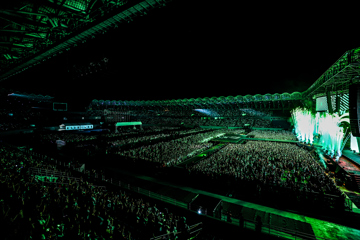Dancing On The Overlap Between Perception & Reality
"There's this idea that identity only comes about through the observation of others; that identity comes from the outside."
At the heart of the experience of being human is the notion of I — identity — and its foundational relationship with the 'not I'. Indeed, our existential engine is fuelled by the ongoing discourse between our internal selves and the external world we move through. What better place for Anouk van Dijk to start the dance.
With her new creation, Lucid, Chunky Move's Dutch born Artistic Director situates us on the shifting bridge between inner and outer worlds, a place where the self is an evolving fusion of influences and where reality and perception overlap.
"There's this idea that identity only comes about through the observation of others; that identity comes from the outside," van Dijk begins. "Our internal identity doesn't really have any value, as such, when we're being perceived by the other."
"Our internal identity doesn't really have any value, as such, when we're being perceived by the other."
To underscore this idea, Lucid takes one dancer (Lauren Langlois) and one actor (Stephen Phillips) and puts them on a stage with five cameras, thereby creating a feedback loop of action and observation and, beyond that, the possibility of a multi-layered identity. As van Dijk explains, "In all my work I'm always interested in how the external is affecting us on all levels."
Don't miss a beat with our FREE daily newsletter
We all experience a visceral interaction with the external; namely, peer and social pressure, self-critical voices in our heads and the impossible religions of beauty, glamour and cool. Here again, Lucid intersects with an external world rich with information about 'how we should be'.
To augment the point, van Dijk brings in an example that many parents would recognise. "I have a 13-year-old at home who is a magician on the iPad. It's a generation that's finding ways to develop identity in that space," she states. "My daughter has such an easy way of dealing with images but she's also aware how it can affect and fuck up her psyche. 13 years old. So I actually think they're more aware of the effects of it because they're native to it. We might learn a lot from them about how to deal with it."
Of course there is an attendant layer of post-modern self-reference here, not so much in the work but in the spectacle of it. If Lucid seeks to address notions of the self in a world dense with media about ideal and non-ideal forms, then Anouk van Dijk recognises that for her audiences the world they will spectate on stage will itself form part of the external tsunami of idealised humanity.
"There's an extension of the whole Warhol, 15 minutes of fame thing," van Dijk responds, pondering the nature of ordinariness in a celebrity fixated culture. "There's reality TV and social media; but also a lot of theatre and dance makers are now reacting to that commercial version by looking more into the realness of real people. But obviously in this piece I'm working with incredibly skilled people who, in that sense, cannot be normal because they're so formed."
With its fluid "organic" set and interplay of live and video imagery, Lucid waxes and wanes between clarity and dreamlike ambiguity. "The interesting thing about the word lucid is that it means absolute clarity but when we use it we often mean deranged or slightly out of whack. So we're working with both sides of the word," van Dijk promises.







